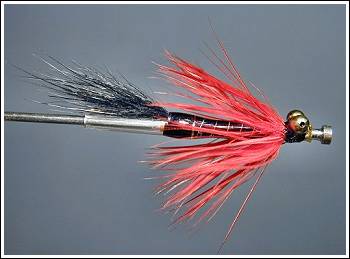|
The Boss
By Bob Kenly

The Boss (black)
After the War of 1812 Great
Britain decided America wasn't worth any more of their time or
resources so left us to wander around the wilderness without their
help, besides they had a pesky French Emperor to deal with. Except
for adopting the English language it seemed to the colonies to be a
good deal, America could become whatever the desired without outside
interference. We never adopted Cricket (too slow), drank our beer
cold, put ice and mix in our whiskey (horrors), drove on the right
side of the street, generally turning our backs on British
traditions. That is until fishing became popular and since we didn't
have a history of fly tying we swallowed our misplaced Yankee pride
and looked back at Europe especially Great Britain for flies. Most
of our flies, in particular Steelhead and salmon patterns, can trace
their roots to Europe. Flies seem to migrate Westward from Europe
but in general not from America to Europe.
(Photo: Lasse B with his Norweigan salmon)
 One place in America where fly tying seems more isolated is Alaska,
except for Canada, America's West Coast and Kamchatka Alaska flies
seem to be relatively isolated in their usage. So, when 34 year old
Lasse B from Oslo, Norway asked if he could have some Alaska flies for
Atlantic salmon to say the least I was intrigued by his strange
request. He had chosen the ridiculously simple pattern known to
everyone who fishes Alaska, The Boss, an all purpose fly tied in
many colors but most commonly with a black body and red collar. I
asked Lasse if using an old Alaska fly might put him in danger when
his friends saw him using such an odd fly he laughed and said that
he was a big rig truck driver and could certainly handle anything
that came along (I can believe that seeing him). Despite the howls
of derision (more like, "What the hell is that thing") Lasse's flies
worked so well for him that they became a favorite of his.
One place in America where fly tying seems more isolated is Alaska,
except for Canada, America's West Coast and Kamchatka Alaska flies
seem to be relatively isolated in their usage. So, when 34 year old
Lasse B from Oslo, Norway asked if he could have some Alaska flies for
Atlantic salmon to say the least I was intrigued by his strange
request. He had chosen the ridiculously simple pattern known to
everyone who fishes Alaska, The Boss, an all purpose fly tied in
many colors but most commonly with a black body and red collar. I
asked Lasse if using an old Alaska fly might put him in danger when
his friends saw him using such an odd fly he laughed and said that
he was a big rig truck driver and could certainly handle anything
that came along (I can believe that seeing him). Despite the howls
of derision (more like, "What the hell is that thing") Lasse's flies
worked so well for him that they became a favorite of his.
I've always wondered why
Lasse had such good luck with this fly but Yuri
Shumakov shed some light on the subject when in 2004 he wrote me
in Alaska and asked me if I knew the reason salmon developed the
hooked jaw when they enter freshwater, of course my answer was to
fight with. True, but Yuri explained that when salmon enter fresh
water they sometimes go on a genocidal killing spree to rid the
waters of egg thieves an the hooked jaws prevent their mouths from
closing thus allowing small fish to escape. He and I have never
witnessed this action but he talked to several salmon authorities
that have seen it in person. It made perfect sense to me especially
in Alaska where I have seen and caught fresh salmon using very
sparsely tied flies like the Mickey Finn just as the salmon enter
fresh water. I suspect that the adventurous Norwegian, Lasse B,
experienced this phenomenon when he fished the Boss.

The Boss
Tying The Boss (tube
version)
Tube: 1 inch (25.4 mm) fine
brass. (I prefer Rooney Tubes for this fly)
Tail: Arctic fox the color
of the body (my preference but you can use any other hair)
Body: thread Covered with
epoxy (being addicted to epoxy that’s how I make mine but there are
other options such as dubbing or floss)
Ribbing: Fine tinsel
Collar: Webby hackle
Eyes: Bead chain
When fished with treble hook
the weight of the eyes will sometimes cause the fly to swim upside
down, not any big deal which is the beauty of this pattern, it looks
good either way.
By Bob Kenly 2007
©
Visit Bob's
website |